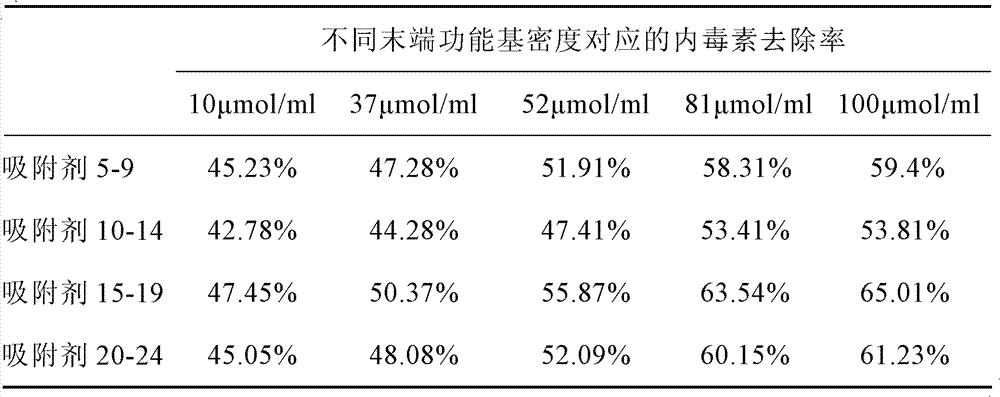Endotoxin adsorbent using molecular cluster as functional group and preparation method thereof
An adsorbent and functional group technology, applied in the fields of bioseparation and biomedical engineering, can solve the problems of difficult preparation of anti-endotoxin drugs and α-polylysine, hidden dangers of polymyxin B toxicity, and unsatisfactory removal effect, etc. , to achieve the effect of overcoming toxicity and instability, good blood compatibility, and stable physical and chemical properties
- Summary
- Abstract
- Description
- Claims
- Application Information
AI Technical Summary
Problems solved by technology
Method used
Image
Examples
Embodiment 1
[0028] Example 1: Preparation of ε-polylysine coupled with lysine as an adsorbent for molecular cluster functional groups
[0029] (1) Epichlorohydrin activated agarose gel
[0030]Take 10ml of the washed Sepharose CL-6B gel, add it to 10ml of an aqueous solution with a concentration of epichlorohydrin of 1% (v / v) and a concentration of NaOH of 0.4M, shake at 40°C at 170rpm for 2 hours, and use Wash the gel with deionized water until neutral;
[0031] (2) Coupling of ε-polylysine
[0032] Prepare 10ml of ε-polylysine aqueous solution with a concentration of 6% (w / v) and a pH of 11, add the gel after the reaction in the previous step and wash it, and stir it with a paddle at 50°C and 300rpm for 3-4h. The gel was thoroughly washed with deionized water;
[0033] (3) Fixation of terminal functional group lysine
[0034] Add a certain mass of lysine to 10ml of MES buffer with pH 4.8 to make the concentration 1% (w / v), then add the gel after the reaction in the previous step, ad...
Embodiment 2
[0035] Example 2: Preparation of ε-polylysine-coupled betaine as an adsorbent for molecular cluster functional groups
[0036] The preparation method of the endotoxin adsorbent 2 with betaine at the end of ε-polylysine is the same as that in Example 1, except that the lysine in step (3) is replaced with betaine, and the other steps and conditions remain unchanged.
Embodiment 3
[0037] Example 3: Preparation of Adsorbent Using Polyaspartic Acid Coupled to Lysine as Molecular Cluster Functional Group
[0038] The preparation method of the adsorbent 3 of polyaspartic acid coupling lysine as molecular cluster functional group comprises four steps, and the first two steps are the same as (1) and (2) in Example 1, only need (2) The epsilon-polylysine in is changed into polyaspartic acid, and all the other conditions are unchanged, and steps (3) and (4) are as follows:
[0039] (3) Connection of the spacer arm
[0040] Add a certain volume of ethylenediamine to 10ml of MES buffer with a pH of 4.8 to make the concentration 10% (v / v), then add the gel after the reaction in the previous step, adjust the pH to 4.8, and then add 0.2g EDC condensing agent, 37°C, 170rpm shaking reaction for 4h, after the reaction is fully washed with deionized water;
[0041] (4) Fixation of terminal functional group lysine
[0042] Add a certain mass of lysine to 10ml of MES b...
PUM
| Property | Measurement | Unit |
|---|---|---|
| molecular weight | aaaaa | aaaaa |
| molecular weight | aaaaa | aaaaa |
| clearance rate | aaaaa | aaaaa |
Abstract
Description
Claims
Application Information
 Login to View More
Login to View More - R&D
- Intellectual Property
- Life Sciences
- Materials
- Tech Scout
- Unparalleled Data Quality
- Higher Quality Content
- 60% Fewer Hallucinations
Browse by: Latest US Patents, China's latest patents, Technical Efficacy Thesaurus, Application Domain, Technology Topic, Popular Technical Reports.
© 2025 PatSnap. All rights reserved.Legal|Privacy policy|Modern Slavery Act Transparency Statement|Sitemap|About US| Contact US: help@patsnap.com


